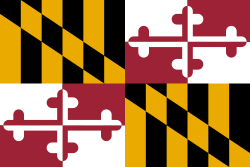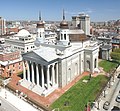Portal:Maryland
Maryland Portal
|
Baltimore Task Force
|
Frederick Task Force
|
Montgomery Task Force
|
WikiProject Maryland
|
Main page
|
Discussion
|
Introduction Maryland (US: /ˈmɛrɪlənd/ ⓘ MERR-il-ənd) is a state in the Mid-Atlantic region and South Atlantic regions of the United States, per the nation's Labor and Commerce departments of the United States. It borders the states of Virginia to its south, West Virginia to its west, Pennsylvania to its north, Delaware and the Atlantic Ocean to its east, and the national capital and federal district of Washington, D.C. to the southwest. With a total area of 12,407 square miles (32,130 km2), Maryland is the ninth-smallest state by land area, and its population of 6,177,224 ranks it the 18th-most populous state and the fifth-most densely populated. Maryland's capital city is Annapolis, and the state's most populous city is Baltimore. Maryland's coastline was first explored by Europeans in the 16th century. Prior to that, it was inhabited by several Native American tribes, mostly the Algonquian peoples. One of the original Thirteen Colonies, the Province of Maryland was founded in 1634 by George Calvert, 1st Baron Baltimore, a Catholic convert who sought to provide a religious haven for Catholics persecuted in England. In 1632, Charles I of England granted Lord Baltimore a colonial charter, naming the colony after his wife, Henrietta Maria. In 1649, the Maryland General Assembly passed an Act Concerning Religion, which enshrined the principle of toleration. Religious strife was common in Maryland's early years, and Catholics remained a minority, albeit in greater numbers than in any other English colony. Maryland's early settlements and population centers clustered around waterways that empty into the Chesapeake Bay. Its economy was heavily plantation-based and centered mostly on the cultivation of tobacco. Demand for cheap labor from Maryland colonists led to the importation of numerous indentured servants and enslaved Africans. In 1760, Maryland's current boundaries took form following the settlement of a long-running border dispute with Pennsylvania. Many of its citizens played key political and military roles in the American Revolutionary War. Although it was a slave state, Maryland remained in the Union during the American Civil War, and its proximity to Washington D.C. and Virginia made it a significant strategic location. After the Civil War ended in 1865, Maryland took part in the Industrial Revolution, driven by its seaports, railroad networks, and mass immigration from Europe. Since the 1940s, the state's population has grown rapidly, to approximately six million residents, and it is among the most densely populated U.S. states. As of 2015, Maryland had the highest median household income of any state, owing in large part to its proximity to Washington, D.C., and a highly diversified economy spanning manufacturing, retail services, public administration, real estate, higher education, information technology, defense contracting, health care, and biotechnology. Maryland is one of the most multicultural states in the country; it is one of the seven states where non-Whites compose a majority of the population, with the fifth-highest percentage of African Americans, and high numbers of residents born in Africa, Asia, Central America, and the Caribbean. The state's central role in U.S. history is reflected by its hosting of some of the highest numbers of historic landmarks per capita. (Full article...) This is a Featured article, which represents some of the best content on English Wikipedia..  The Baltimore Steam Packet Company, nicknamed the Old Bay Line, was an American steamship line from 1840 to 1962 that provided overnight steamboat service on Chesapeake Bay, primarily between Baltimore, Maryland, and Norfolk, Virginia. Called a "packet" for the mail packets carried on government mail contracts, the term in the 19th century came to mean a steamer line operating on a regular, fixed daily schedule between two or more cities. When it closed in 1962 after 122 years of existence, it was the last surviving overnight steamship passenger service in the United States. In addition to regularly calling on Baltimore and Norfolk, the Baltimore Steam Packet Company at various times provided freight, passenger and vehicle transport to Washington, D.C., Old Point Comfort, and Richmond, Virginia. The Old Bay Line, as it came to be known by the 1860s, was acclaimed for its genteel service and fine dining, serving Chesapeake Bay specialties. Walter Lord, famed author of A Night to Remember (and whose grandfather had been the packet line's president from 1893 to 1899), mused that its reputation for excellent service was attributable to "some magical blending of the best in the North and the South, made possible by the Company's unique role in 'bridging' the two sections...the North contributed its tradition of mechanical proficiency, making the ships so reliable; while the South contributed its gracious ease". (Full article...) General imagesIn the news
On this day...The Maryland portal currently doesn't have any anniversaries listed for April 9. You can help by viewing the page source of an existing entry at /On this day to see how the entries should be formatted, then adding the missing entry. This is a Good article, an article that meets a core set of high editorial standards. The music of Baltimore, the largest city in Maryland, can be documented as far back as 1784, and the city has become a regional center for Western classical music and jazz. Early Baltimore was home to popular opera and musical theatre, and an important part of the music of Maryland, while the city also hosted several major music publishing firms until well into the 19th century, when Baltimore also saw the rise of native musical instrument manufacturing, specifically pianos and woodwind instruments. African American music existed in Baltimore during the colonial era, and the city was home to vibrant black musical life by the 1860s. Baltimore's African American heritage to the start of the 20th century included ragtime and gospel music. By the end of that century, Baltimore jazz had become a well-recognized scene among jazz fans, and produced a number of local performers to gain national reputations. The city was a major stop on the African American East Coast touring circuit, and it remains a popular regional draw for live performances. Baltimore has produced a wide range of modern rock, punk and metal bands and several indie labels catering to a variety of audiences. Music education throughout Maryland conforms to state education standards, implemented by the Baltimore City Public School System. Music is taught to all age groups, and the city is also home to several institutes of higher education in music. The Peabody Institute's Conservatory is the most renowned music education facility in the area, and has been one of the top nationally for decades. The city is also home to a number of other institutes of higher education that have music programs, the largest being nearby Towson University. The Peabody sponsors performances of many kinds, many of them classical or chamber music. Baltimore is home to the Baltimore Opera and the Baltimore Symphony Orchestra, among other similar performance groups. Major music venues in Baltimore include the nightclubs and other establishments that offer live entertainment clustered in Fells Point and Federal Hill. (Full article...) Selected article -Mount St. Mary's University is a private Catholic university in Emmitsburg, Maryland. It has the largest Catholic seminary in the United States. Undergraduate programs are divided between the College of Liberal Arts, the Richard J. Bolte School of Business, and the School of Natural Science and Mathematics. "The Mount" has over 40 undergraduate majors, minors, concentrations, and special programs, as well as bachelor's/master's combinations in partnership with other universities, 8 master's programs, and 6 postgraduate certificate programs. (Full article...) Did you know?

SubcategoriesSelect [+] to view subcategories TopicsRelated portalsAssociated WikimediaThe following Wikimedia Foundation sister projects provide more on this subject:
Discover Wikipedia using portals
|






















































